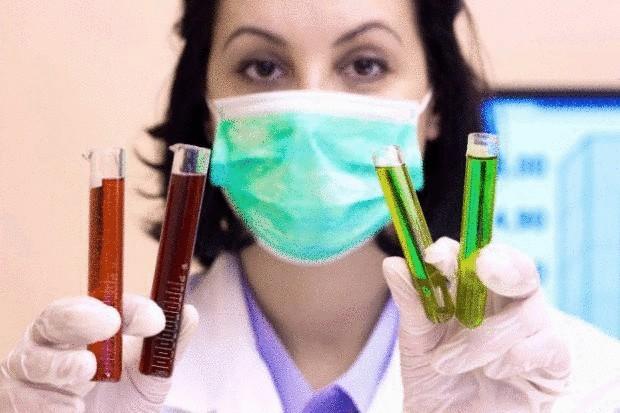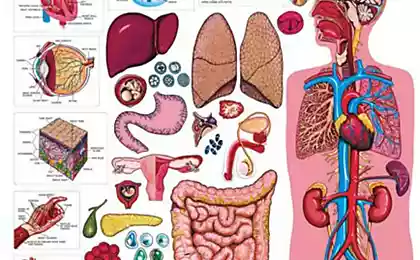549
10 amazing theories about the spread of disease
History of the study of diseases has for thousands of years, and at different times in different countries there were many theories about how the disease spreads among humans. Despite all the advances of science and medicine, disease outbreaks — are still not uncommon. Many people suspect that a plague is one of the possible scenarios of the destruction of our world as we know it, and knowing how fragmentary our knowledge about the disease remain for centuries is staggering.1. Xenophobia and rudeness fight against the disease 
The fact that we know how microbes "work" and as subject, does not mean that scientists do not build new theories. Biologists from the University of new Mexico and the University of British Columbia suspect that we came up with a rather ingenious way of preventing the spread of diseases in a culture for centuries: we are rude.
In a nutshell, the theory States that our culture tends to avoid and shun strangers and outsiders to be sure that their germs will not pass to us. The study addressed a wide range of crops and in the process, it was determined that disease outbreaks are less common in small groups with their own cultural identity and language, than for the more extensive crops.
The researchers also argue that people in areas with lower incidence rates are more reserved and less friendly to strangers. This is the place where hugs and kisses as greetings less than acceptable. There is also a more developed system of a taboo, especially in relation to food — thanks to these bans, people do not use dangerous pathogens. Theory suggests that the memory of the disease played a surprisingly large role in the formation of culture around the world.
2. Five second rule
We have all heard that if you drop food on the ground and pick it up in less than five seconds, it's still good. Despite the shocking number of different studies of this phenomenon, the scientists can't decide whether it's true or not.
According to researchers from Clemson University, some bacteria such as Salmonella can live on an ordinary kitchen floor down to the month and immediately move on the fallen food. In another study, Aston University in the UK, however, tested the transition of Escherichia coli and Staphylococcus floors with different types of food, and found that the longer food was on the floor, the more bacteria it was.
It is important to note that these two studies looked at how different types of bacteria, it is therefore likely that different bacteria act in different ways. It may be easier and safer to refrain from eating what you dropped.
3. Sent by the gods
In Ancient Greece little was known about bacteria and the spread of diseases between people. The ancient Greeks believed that disease people afflicted by the gods, and only one person that caused the anger of Zeus, was the cause of the plague, which covered the whole city. Apollo and Artemis are often thought to bring disease to the men and women who irritated them. In another myth in the liberation of disease accused Pandora who opened the box, although some texts, such as "the Odyssey", I suppose both versions are true.
The perfume, which was released Pandora, in Greek was called Nesoi. In Rome these personification of disease and decay was called Luz, Tarbes, Mace, Morbus and pestis. Nosoi got personal characteristics, like other gods: Morbus carried exhaustion, pestis was greedy, and all they managed to Eriniya, the goddess of revenge. According to Hesiod, when Nozoe was created by Zeus, he gave them ability to speak, so nobody could hear us coming and escape them.
4. The Work Of Robert Koch
Robert Koch
All the knowledge we have today about bacteria, based on the Foundation laid by Robert Koch. German scientist who learned to read using the Newspapers when he was five years old, studied at the University of göttingen under the leadership of Jacob Henle, who developed the theory that the cause of the disease was some sort of mysterious organism or parasite.
After participating in the Franco-Prussian war, Koch established his own laboratory at home. With a microscope and some improvised equipment, he proceeded to the definition of what bacteria are and how they relate to anthrax. Later he attributed the proof that the cause of the disease are bacteria that can be transmitted from one person to another through blood.
Koch also found that bacteria can survive in adverse conditions, creating spores that can wait out the cold and create a new bacteria, once the environment improves. He experimented with different methods of cultivation of bacteria, which allowed them better explore and identify conditions conducive to their spread. Perhaps his main merit is that he wrote recommendations for the control of infectious diseases, including important note about the need to maintain the purity of water.
5. Miasma
In the Middle ages one of the main theories about the spread of disease was a theory about the existence of miasma — poisonous gas coming out of the ground during the decomposition of plants and animals. From China to Europe it was scientifically accepted explanation for the spread of disease for centuries.
In the early 1800-ies the French chemist Bossenga performed a series of experiments to confirm the existence of miasma and its impact on people. His search for a hypothetical compound of hydrogen, which was the cause of disease, the composition miasma was not successful, but discussions with other scientists, Justus von Liebig, helped him to take a step forward in finding the true culprit. Liebig theorized that something in the composition miasma, not the miasma getting into the bloodstream of the people, infects them.
The idea that miasma somehow causes the disease, became more and more probable with the growth of cities, especially in the summer of 1858, the year when Victorian London struck the Great stink caused by improper process of getting rid of waste. The subsequent cholera outbreak, would seem to confirm the theory miasma. Even Florence Nightingale believed in it, stating that one of the main sources of infection are the drains in houses, which allowed the polluted air to come home and infect entire families.
6. Spontaneous appearance
Today it seems impossible that people believed in the spontaneous appearance of the disease in 1859, the year, but until the end of the XIX-th century there were recipes to create life out of nothing, for example, mice from wheat husk and sweaty underwear placed in a jar.
Eleven million five hundred eight thousand four hundred eighty two
John Needham
In 1745, the year of a priest named John Needham boiled chicken broth, until it disappears all the germs, closed it in a jar, and later opened it to show that the soup thickens, and hence, microbes became more. It supposedly was regarded as evidence of spontaneous generation of microorganisms.
The first theory about germs seemed to only confirm the hypothesis of spontaneous generation. It was thought that microbes were a byproduct of the disease rather than its cause, which is the idea of their spontaneous generation in the body from nothing. Right up until Louis Pasteur in 1859, the year not published his work on this issue, completely refuting this theory.
7. Lady Mary Wortley Montagu and inoculation
Lady Mary Wortley Montagu was a British aristocrat and the wife of the Turkish Ambassador. When the Ambassador sent to Turkey in 1716, the year he decided to take his wife with him. At that time he did not anticipate that this act will make a huge contribution to the development of Western knowledge about disease prevention.
Smallpox is disfiguring, and in some cases deadly disease that ravaged England during the reign of Elizabeth I. Now we know that the plague was raging in Ancient Egypt. During your stay in Turkey Montagu saw several old women who treated children through puncturing the vein and introducing a small amount of smallpox into the blood. As a result, the children endured a mild form of the disease, quickly recovered and got lifelong immunity to the disease.
Lady Montague was amazed by this and returned to England with knowledge. She even did these procedures on their own children. Many were skeptical, so lady Montagu and the wife of the Prince of Wales decided to prove that it is safe, by convincing a group of prisoners in Newgate prison to be vaccinated. Prisoners death row life was given for their participation in the "Royal experiment".
8. Ayurveda and bodily fluids
One of the most common in the history of ideas about causes of diseases — is the idea that the body that something is wrong with the balance. In Ancient Greece it was believed that the body has four fluids, each of which controls some part of the body. All fluids — black bile, yellow bile, blood and phlegm — must be in balance to be healthy, and many therapies have focused on maintaining this balance.
This theory was first formulated by Hippocrates and Galen in 200 year BC, but the idea is much older. In ancient Indian medicine, or Ayurveda, developed between 700-m and 400-m years BC, it is believed that the imbalance the three doshas (Pitta, Vata and Kapha) is the cause of the disease. System allowing Ayurvedic doctors to balance the doshas that are popular today.
According to traditional Chinese medicine, which has existed for over 2000 years, the disease easier to spread in the body with an imbalance of qi, or life force. The return of the body balance and promote many treatments, such as acupuncture.
9. Superastronomical is not аномалия
Superastronomical are people who for one reason or another, infecting a large number of people. One of the most famous Typhoid Mary, infecting many people with typhoid, she is not ill.
When researchers study the spread of the disease, to determine why they pay attention to a variety of factors, including the number of people among the whole population more vulnerable to disease, and the number of people that can infect one person. For a long time it was believed that superastronomical is the anomaly. However, it appeared that this was a false assumption. In fact, the chance that your house has superastronomical is large enough.
The most productive superesportes are children. It was found that vaccination of 20% of children more productive in preventing the spread of diseases like the flu than vaccinating 90% of people over the age of 65 years. Due to not fully developed immune system, children are more contagious than adults, and they usually are in contact with a large number of people, for example, in school and after-school activities.
10. The theory of infection
The first theory of infection suggested the Greek physician and philosopher Galen, who had previously proposed the theory of the four liquids. What we now call germs, Galen called seeds of disease. He guessed that these seeds present in the body some people, this also he explained why some people got sick and others did not.
Twenty six million six hundred forty five thousand six hundred sixty nine
This theory was rejected in favor of the theory of the four fluids, perhaps because it was not possible to prove or deny it, while the fluid was in all people. The theory has received new life, when in the sixteenth-century physician Girolamo frakastoro began to write about the spread of the disease. He not only believed that only the person in whose body were these seeds was sick, he also suggested that they can be transmitted from person to person.
Thanks Frakastoro in Italy was imposed quarantine, which helped to limit the disease, however, despite all the good that he brought, he made some errors. Frakastoro suggested that these seeds spontaneously appear in the body and some are rooted in certain liquids. These disease-causing seeds to be removed from the body by blowing of the corresponding liquid. His theory soon came under doubt because it is impossible to prove, and after about 1650, the year he has faded into obscurity.
Source: /users/1077

The fact that we know how microbes "work" and as subject, does not mean that scientists do not build new theories. Biologists from the University of new Mexico and the University of British Columbia suspect that we came up with a rather ingenious way of preventing the spread of diseases in a culture for centuries: we are rude.
In a nutshell, the theory States that our culture tends to avoid and shun strangers and outsiders to be sure that their germs will not pass to us. The study addressed a wide range of crops and in the process, it was determined that disease outbreaks are less common in small groups with their own cultural identity and language, than for the more extensive crops.
The researchers also argue that people in areas with lower incidence rates are more reserved and less friendly to strangers. This is the place where hugs and kisses as greetings less than acceptable. There is also a more developed system of a taboo, especially in relation to food — thanks to these bans, people do not use dangerous pathogens. Theory suggests that the memory of the disease played a surprisingly large role in the formation of culture around the world.
2. Five second rule

We have all heard that if you drop food on the ground and pick it up in less than five seconds, it's still good. Despite the shocking number of different studies of this phenomenon, the scientists can't decide whether it's true or not.
According to researchers from Clemson University, some bacteria such as Salmonella can live on an ordinary kitchen floor down to the month and immediately move on the fallen food. In another study, Aston University in the UK, however, tested the transition of Escherichia coli and Staphylococcus floors with different types of food, and found that the longer food was on the floor, the more bacteria it was.
It is important to note that these two studies looked at how different types of bacteria, it is therefore likely that different bacteria act in different ways. It may be easier and safer to refrain from eating what you dropped.
3. Sent by the gods

In Ancient Greece little was known about bacteria and the spread of diseases between people. The ancient Greeks believed that disease people afflicted by the gods, and only one person that caused the anger of Zeus, was the cause of the plague, which covered the whole city. Apollo and Artemis are often thought to bring disease to the men and women who irritated them. In another myth in the liberation of disease accused Pandora who opened the box, although some texts, such as "the Odyssey", I suppose both versions are true.
The perfume, which was released Pandora, in Greek was called Nesoi. In Rome these personification of disease and decay was called Luz, Tarbes, Mace, Morbus and pestis. Nosoi got personal characteristics, like other gods: Morbus carried exhaustion, pestis was greedy, and all they managed to Eriniya, the goddess of revenge. According to Hesiod, when Nozoe was created by Zeus, he gave them ability to speak, so nobody could hear us coming and escape them.
4. The Work Of Robert Koch

Robert Koch
All the knowledge we have today about bacteria, based on the Foundation laid by Robert Koch. German scientist who learned to read using the Newspapers when he was five years old, studied at the University of göttingen under the leadership of Jacob Henle, who developed the theory that the cause of the disease was some sort of mysterious organism or parasite.
After participating in the Franco-Prussian war, Koch established his own laboratory at home. With a microscope and some improvised equipment, he proceeded to the definition of what bacteria are and how they relate to anthrax. Later he attributed the proof that the cause of the disease are bacteria that can be transmitted from one person to another through blood.
Koch also found that bacteria can survive in adverse conditions, creating spores that can wait out the cold and create a new bacteria, once the environment improves. He experimented with different methods of cultivation of bacteria, which allowed them better explore and identify conditions conducive to their spread. Perhaps his main merit is that he wrote recommendations for the control of infectious diseases, including important note about the need to maintain the purity of water.
5. Miasma

In the Middle ages one of the main theories about the spread of disease was a theory about the existence of miasma — poisonous gas coming out of the ground during the decomposition of plants and animals. From China to Europe it was scientifically accepted explanation for the spread of disease for centuries.
In the early 1800-ies the French chemist Bossenga performed a series of experiments to confirm the existence of miasma and its impact on people. His search for a hypothetical compound of hydrogen, which was the cause of disease, the composition miasma was not successful, but discussions with other scientists, Justus von Liebig, helped him to take a step forward in finding the true culprit. Liebig theorized that something in the composition miasma, not the miasma getting into the bloodstream of the people, infects them.
The idea that miasma somehow causes the disease, became more and more probable with the growth of cities, especially in the summer of 1858, the year when Victorian London struck the Great stink caused by improper process of getting rid of waste. The subsequent cholera outbreak, would seem to confirm the theory miasma. Even Florence Nightingale believed in it, stating that one of the main sources of infection are the drains in houses, which allowed the polluted air to come home and infect entire families.
6. Spontaneous appearance

Today it seems impossible that people believed in the spontaneous appearance of the disease in 1859, the year, but until the end of the XIX-th century there were recipes to create life out of nothing, for example, mice from wheat husk and sweaty underwear placed in a jar.
Eleven million five hundred eight thousand four hundred eighty two
John Needham
In 1745, the year of a priest named John Needham boiled chicken broth, until it disappears all the germs, closed it in a jar, and later opened it to show that the soup thickens, and hence, microbes became more. It supposedly was regarded as evidence of spontaneous generation of microorganisms.
The first theory about germs seemed to only confirm the hypothesis of spontaneous generation. It was thought that microbes were a byproduct of the disease rather than its cause, which is the idea of their spontaneous generation in the body from nothing. Right up until Louis Pasteur in 1859, the year not published his work on this issue, completely refuting this theory.
7. Lady Mary Wortley Montagu and inoculation

Lady Mary Wortley Montagu was a British aristocrat and the wife of the Turkish Ambassador. When the Ambassador sent to Turkey in 1716, the year he decided to take his wife with him. At that time he did not anticipate that this act will make a huge contribution to the development of Western knowledge about disease prevention.
Smallpox is disfiguring, and in some cases deadly disease that ravaged England during the reign of Elizabeth I. Now we know that the plague was raging in Ancient Egypt. During your stay in Turkey Montagu saw several old women who treated children through puncturing the vein and introducing a small amount of smallpox into the blood. As a result, the children endured a mild form of the disease, quickly recovered and got lifelong immunity to the disease.
Lady Montague was amazed by this and returned to England with knowledge. She even did these procedures on their own children. Many were skeptical, so lady Montagu and the wife of the Prince of Wales decided to prove that it is safe, by convincing a group of prisoners in Newgate prison to be vaccinated. Prisoners death row life was given for their participation in the "Royal experiment".
8. Ayurveda and bodily fluids

One of the most common in the history of ideas about causes of diseases — is the idea that the body that something is wrong with the balance. In Ancient Greece it was believed that the body has four fluids, each of which controls some part of the body. All fluids — black bile, yellow bile, blood and phlegm — must be in balance to be healthy, and many therapies have focused on maintaining this balance.
This theory was first formulated by Hippocrates and Galen in 200 year BC, but the idea is much older. In ancient Indian medicine, or Ayurveda, developed between 700-m and 400-m years BC, it is believed that the imbalance the three doshas (Pitta, Vata and Kapha) is the cause of the disease. System allowing Ayurvedic doctors to balance the doshas that are popular today.
According to traditional Chinese medicine, which has existed for over 2000 years, the disease easier to spread in the body with an imbalance of qi, or life force. The return of the body balance and promote many treatments, such as acupuncture.
9. Superastronomical is not аномалия

Superastronomical are people who for one reason or another, infecting a large number of people. One of the most famous Typhoid Mary, infecting many people with typhoid, she is not ill.
When researchers study the spread of the disease, to determine why they pay attention to a variety of factors, including the number of people among the whole population more vulnerable to disease, and the number of people that can infect one person. For a long time it was believed that superastronomical is the anomaly. However, it appeared that this was a false assumption. In fact, the chance that your house has superastronomical is large enough.
The most productive superesportes are children. It was found that vaccination of 20% of children more productive in preventing the spread of diseases like the flu than vaccinating 90% of people over the age of 65 years. Due to not fully developed immune system, children are more contagious than adults, and they usually are in contact with a large number of people, for example, in school and after-school activities.
10. The theory of infection

The first theory of infection suggested the Greek physician and philosopher Galen, who had previously proposed the theory of the four liquids. What we now call germs, Galen called seeds of disease. He guessed that these seeds present in the body some people, this also he explained why some people got sick and others did not.
Twenty six million six hundred forty five thousand six hundred sixty nine
This theory was rejected in favor of the theory of the four fluids, perhaps because it was not possible to prove or deny it, while the fluid was in all people. The theory has received new life, when in the sixteenth-century physician Girolamo frakastoro began to write about the spread of the disease. He not only believed that only the person in whose body were these seeds was sick, he also suggested that they can be transmitted from person to person.
Thanks Frakastoro in Italy was imposed quarantine, which helped to limit the disease, however, despite all the good that he brought, he made some errors. Frakastoro suggested that these seeds spontaneously appear in the body and some are rooted in certain liquids. These disease-causing seeds to be removed from the body by blowing of the corresponding liquid. His theory soon came under doubt because it is impossible to prove, and after about 1650, the year he has faded into obscurity.
Source: /users/1077























